Communication Strategies for Qantas and Tigerair Airways
VerifiedAdded on 2023/03/31
|9
|2810
|496
AI Summary
This report analyzes the communication strategies of Qantas and Tigerair Airways, focusing on their non-electronic and electronic methods. It evaluates their strengths, weaknesses, opportunities, and threats in communication. Recommendations are provided for improving their strategies.
Contribute Materials
Your contribution can guide someone’s learning journey. Share your
documents today.
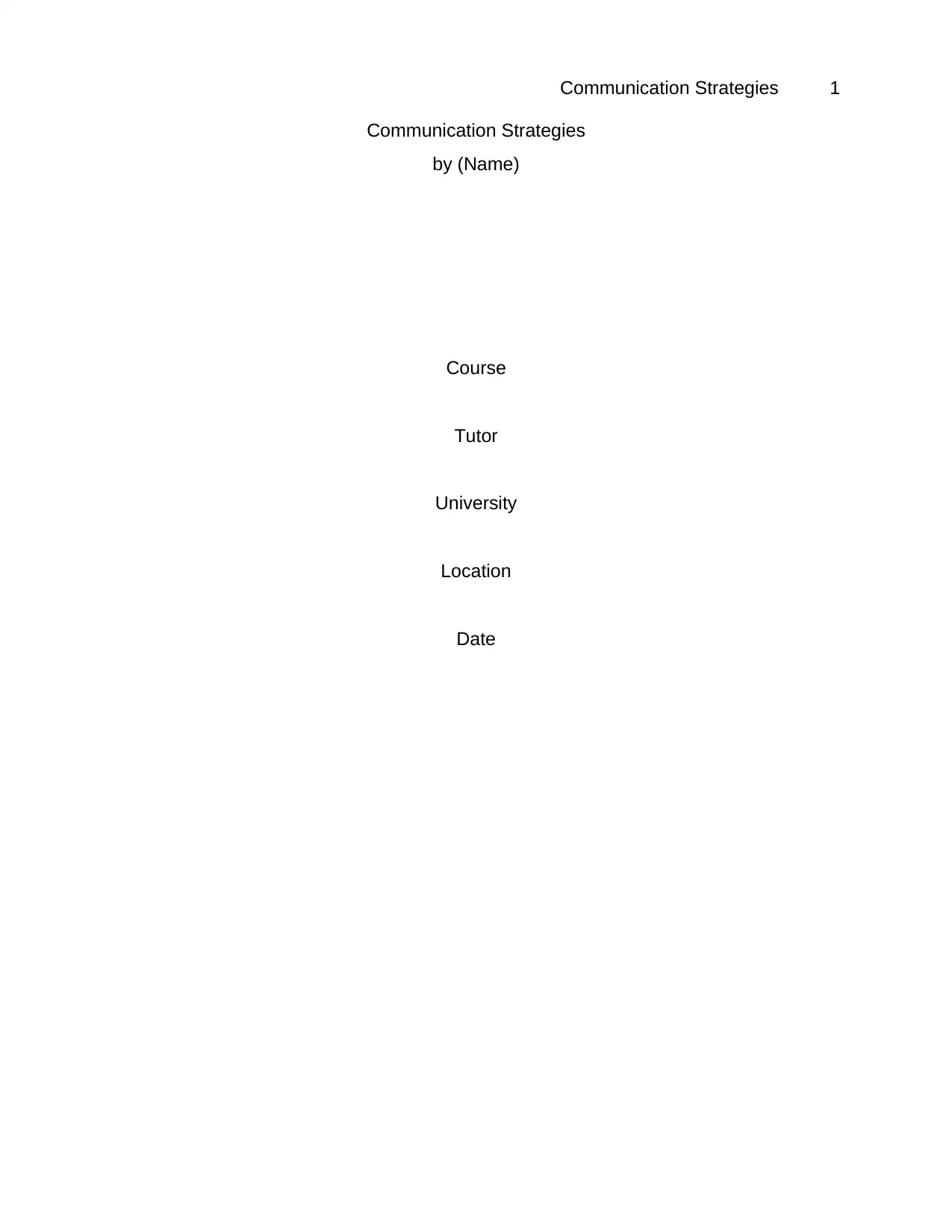
Communication Strategies 1
Communication Strategies
by (Name)
Course
Tutor
University
Location
Date
Communication Strategies
by (Name)
Course
Tutor
University
Location
Date
Secure Best Marks with AI Grader
Need help grading? Try our AI Grader for instant feedback on your assignments.
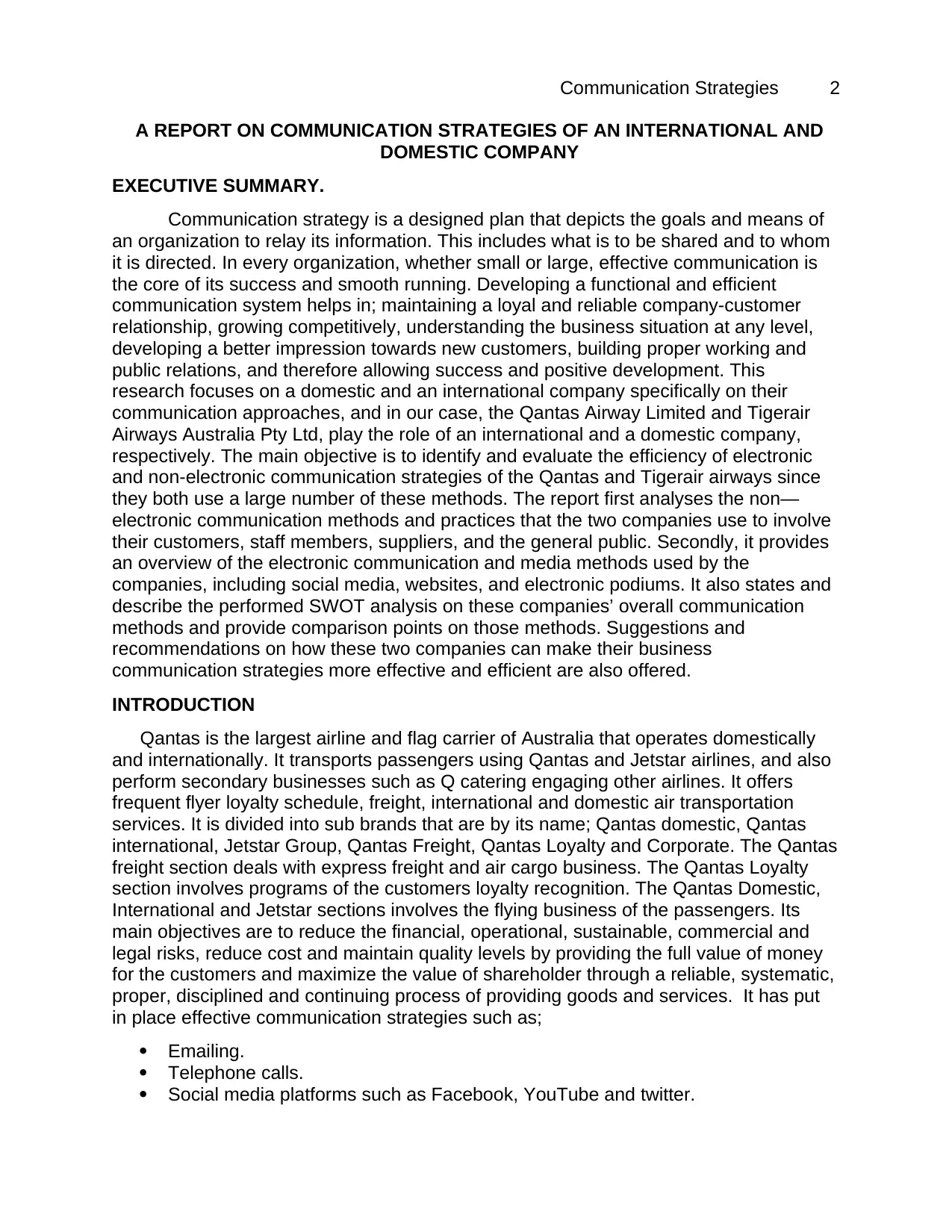
Communication Strategies 2
A REPORT ON COMMUNICATION STRATEGIES OF AN INTERNATIONAL AND
DOMESTIC COMPANY
EXECUTIVE SUMMARY.
Communication strategy is a designed plan that depicts the goals and means of
an organization to relay its information. This includes what is to be shared and to whom
it is directed. In every organization, whether small or large, effective communication is
the core of its success and smooth running. Developing a functional and efficient
communication system helps in; maintaining a loyal and reliable company-customer
relationship, growing competitively, understanding the business situation at any level,
developing a better impression towards new customers, building proper working and
public relations, and therefore allowing success and positive development. This
research focuses on a domestic and an international company specifically on their
communication approaches, and in our case, the Qantas Airway Limited and Tigerair
Airways Australia Pty Ltd, play the role of an international and a domestic company,
respectively. The main objective is to identify and evaluate the efficiency of electronic
and non-electronic communication strategies of the Qantas and Tigerair airways since
they both use a large number of these methods. The report first analyses the non—
electronic communication methods and practices that the two companies use to involve
their customers, staff members, suppliers, and the general public. Secondly, it provides
an overview of the electronic communication and media methods used by the
companies, including social media, websites, and electronic podiums. It also states and
describe the performed SWOT analysis on these companies’ overall communication
methods and provide comparison points on those methods. Suggestions and
recommendations on how these two companies can make their business
communication strategies more effective and efficient are also offered.
INTRODUCTION
Qantas is the largest airline and flag carrier of Australia that operates domestically
and internationally. It transports passengers using Qantas and Jetstar airlines, and also
perform secondary businesses such as Q catering engaging other airlines. It offers
frequent flyer loyalty schedule, freight, international and domestic air transportation
services. It is divided into sub brands that are by its name; Qantas domestic, Qantas
international, Jetstar Group, Qantas Freight, Qantas Loyalty and Corporate. The Qantas
freight section deals with express freight and air cargo business. The Qantas Loyalty
section involves programs of the customers loyalty recognition. The Qantas Domestic,
International and Jetstar sections involves the flying business of the passengers. Its
main objectives are to reduce the financial, operational, sustainable, commercial and
legal risks, reduce cost and maintain quality levels by providing the full value of money
for the customers and maximize the value of shareholder through a reliable, systematic,
proper, disciplined and continuing process of providing goods and services. It has put
in place effective communication strategies such as;
Emailing.
Telephone calls.
Social media platforms such as Facebook, YouTube and twitter.
A REPORT ON COMMUNICATION STRATEGIES OF AN INTERNATIONAL AND
DOMESTIC COMPANY
EXECUTIVE SUMMARY.
Communication strategy is a designed plan that depicts the goals and means of
an organization to relay its information. This includes what is to be shared and to whom
it is directed. In every organization, whether small or large, effective communication is
the core of its success and smooth running. Developing a functional and efficient
communication system helps in; maintaining a loyal and reliable company-customer
relationship, growing competitively, understanding the business situation at any level,
developing a better impression towards new customers, building proper working and
public relations, and therefore allowing success and positive development. This
research focuses on a domestic and an international company specifically on their
communication approaches, and in our case, the Qantas Airway Limited and Tigerair
Airways Australia Pty Ltd, play the role of an international and a domestic company,
respectively. The main objective is to identify and evaluate the efficiency of electronic
and non-electronic communication strategies of the Qantas and Tigerair airways since
they both use a large number of these methods. The report first analyses the non—
electronic communication methods and practices that the two companies use to involve
their customers, staff members, suppliers, and the general public. Secondly, it provides
an overview of the electronic communication and media methods used by the
companies, including social media, websites, and electronic podiums. It also states and
describe the performed SWOT analysis on these companies’ overall communication
methods and provide comparison points on those methods. Suggestions and
recommendations on how these two companies can make their business
communication strategies more effective and efficient are also offered.
INTRODUCTION
Qantas is the largest airline and flag carrier of Australia that operates domestically
and internationally. It transports passengers using Qantas and Jetstar airlines, and also
perform secondary businesses such as Q catering engaging other airlines. It offers
frequent flyer loyalty schedule, freight, international and domestic air transportation
services. It is divided into sub brands that are by its name; Qantas domestic, Qantas
international, Jetstar Group, Qantas Freight, Qantas Loyalty and Corporate. The Qantas
freight section deals with express freight and air cargo business. The Qantas Loyalty
section involves programs of the customers loyalty recognition. The Qantas Domestic,
International and Jetstar sections involves the flying business of the passengers. Its
main objectives are to reduce the financial, operational, sustainable, commercial and
legal risks, reduce cost and maintain quality levels by providing the full value of money
for the customers and maximize the value of shareholder through a reliable, systematic,
proper, disciplined and continuing process of providing goods and services. It has put
in place effective communication strategies such as;
Emailing.
Telephone calls.
Social media platforms such as Facebook, YouTube and twitter.
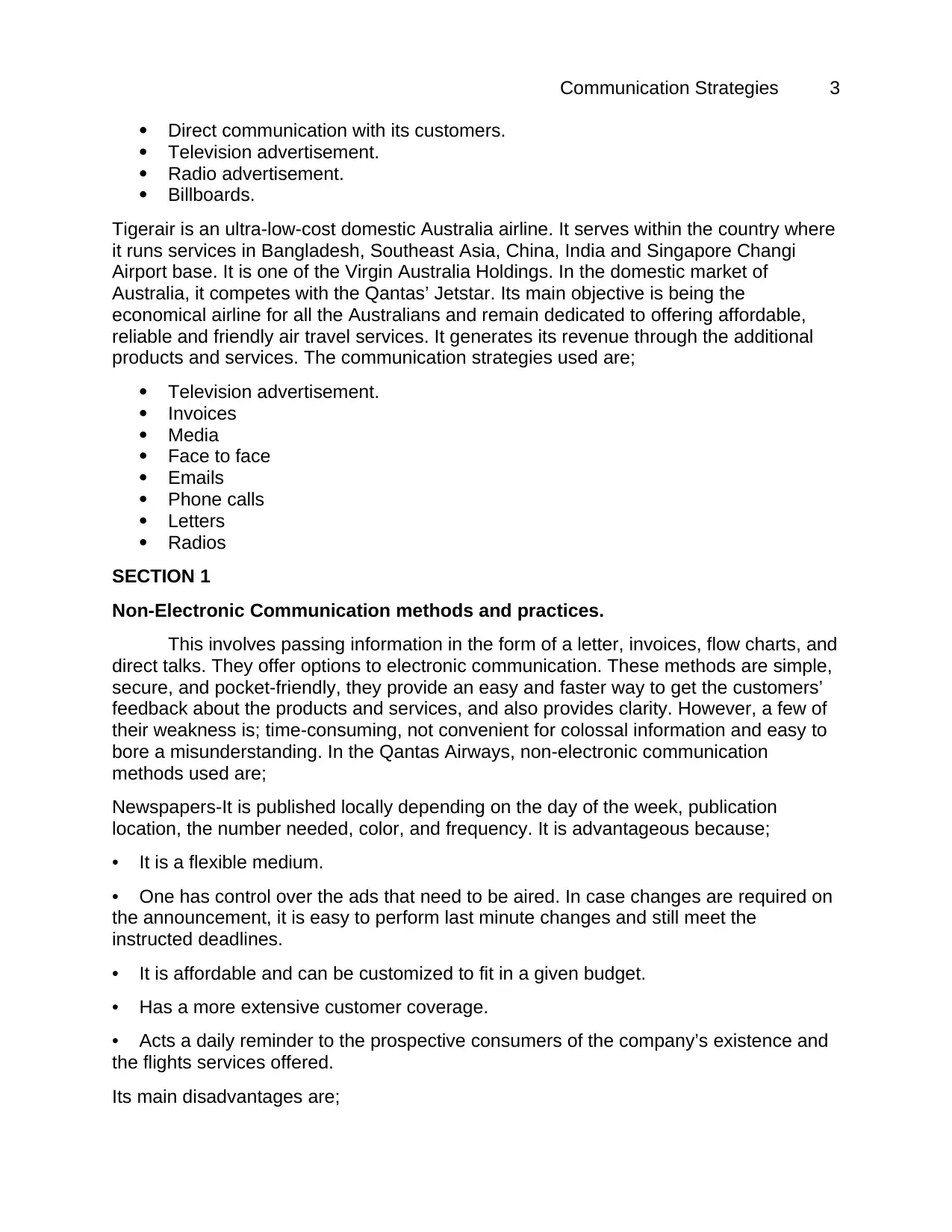
Communication Strategies 3
Direct communication with its customers.
Television advertisement.
Radio advertisement.
Billboards.
Tigerair is an ultra-low-cost domestic Australia airline. It serves within the country where
it runs services in Bangladesh, Southeast Asia, China, India and Singapore Changi
Airport base. It is one of the Virgin Australia Holdings. In the domestic market of
Australia, it competes with the Qantas’ Jetstar. Its main objective is being the
economical airline for all the Australians and remain dedicated to offering affordable,
reliable and friendly air travel services. It generates its revenue through the additional
products and services. The communication strategies used are;
Television advertisement.
Invoices
Media
Face to face
Emails
Phone calls
Letters
Radios
SECTION 1
Non-Electronic Communication methods and practices.
This involves passing information in the form of a letter, invoices, flow charts, and
direct talks. They offer options to electronic communication. These methods are simple,
secure, and pocket-friendly, they provide an easy and faster way to get the customers’
feedback about the products and services, and also provides clarity. However, a few of
their weakness is; time-consuming, not convenient for colossal information and easy to
bore a misunderstanding. In the Qantas Airways, non-electronic communication
methods used are;
Newspapers-It is published locally depending on the day of the week, publication
location, the number needed, color, and frequency. It is advantageous because;
• It is a flexible medium.
• One has control over the ads that need to be aired. In case changes are required on
the announcement, it is easy to perform last minute changes and still meet the
instructed deadlines.
• It is affordable and can be customized to fit in a given budget.
• Has a more extensive customer coverage.
• Acts a daily reminder to the prospective consumers of the company’s existence and
the flights services offered.
Its main disadvantages are;
Direct communication with its customers.
Television advertisement.
Radio advertisement.
Billboards.
Tigerair is an ultra-low-cost domestic Australia airline. It serves within the country where
it runs services in Bangladesh, Southeast Asia, China, India and Singapore Changi
Airport base. It is one of the Virgin Australia Holdings. In the domestic market of
Australia, it competes with the Qantas’ Jetstar. Its main objective is being the
economical airline for all the Australians and remain dedicated to offering affordable,
reliable and friendly air travel services. It generates its revenue through the additional
products and services. The communication strategies used are;
Television advertisement.
Invoices
Media
Face to face
Emails
Phone calls
Letters
Radios
SECTION 1
Non-Electronic Communication methods and practices.
This involves passing information in the form of a letter, invoices, flow charts, and
direct talks. They offer options to electronic communication. These methods are simple,
secure, and pocket-friendly, they provide an easy and faster way to get the customers’
feedback about the products and services, and also provides clarity. However, a few of
their weakness is; time-consuming, not convenient for colossal information and easy to
bore a misunderstanding. In the Qantas Airways, non-electronic communication
methods used are;
Newspapers-It is published locally depending on the day of the week, publication
location, the number needed, color, and frequency. It is advantageous because;
• It is a flexible medium.
• One has control over the ads that need to be aired. In case changes are required on
the announcement, it is easy to perform last minute changes and still meet the
instructed deadlines.
• It is affordable and can be customized to fit in a given budget.
• Has a more extensive customer coverage.
• Acts a daily reminder to the prospective consumers of the company’s existence and
the flights services offered.
Its main disadvantages are;
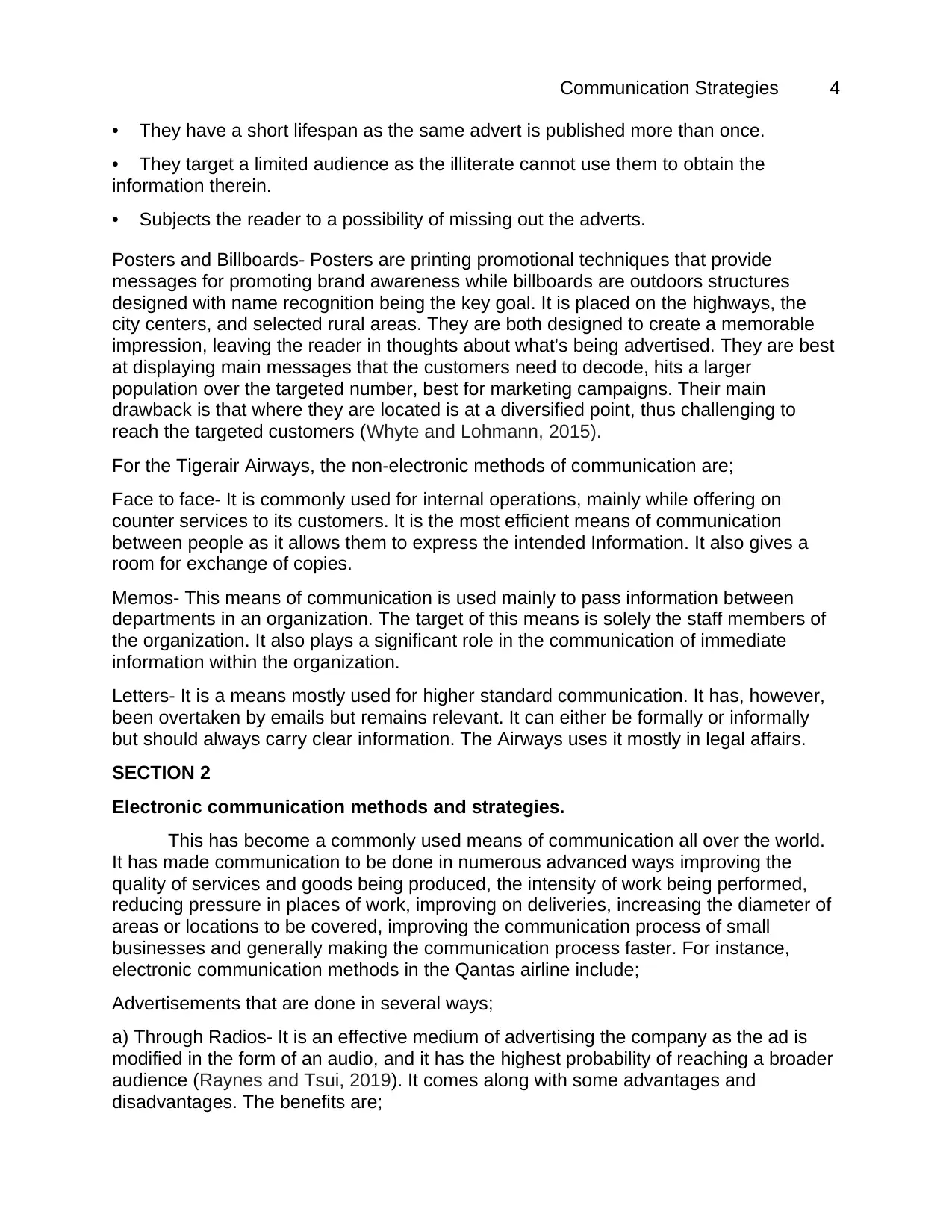
Communication Strategies 4
• They have a short lifespan as the same advert is published more than once.
• They target a limited audience as the illiterate cannot use them to obtain the
information therein.
• Subjects the reader to a possibility of missing out the adverts.
Posters and Billboards- Posters are printing promotional techniques that provide
messages for promoting brand awareness while billboards are outdoors structures
designed with name recognition being the key goal. It is placed on the highways, the
city centers, and selected rural areas. They are both designed to create a memorable
impression, leaving the reader in thoughts about what’s being advertised. They are best
at displaying main messages that the customers need to decode, hits a larger
population over the targeted number, best for marketing campaigns. Their main
drawback is that where they are located is at a diversified point, thus challenging to
reach the targeted customers (Whyte and Lohmann, 2015).
For the Tigerair Airways, the non-electronic methods of communication are;
Face to face- It is commonly used for internal operations, mainly while offering on
counter services to its customers. It is the most efficient means of communication
between people as it allows them to express the intended Information. It also gives a
room for exchange of copies.
Memos- This means of communication is used mainly to pass information between
departments in an organization. The target of this means is solely the staff members of
the organization. It also plays a significant role in the communication of immediate
information within the organization.
Letters- It is a means mostly used for higher standard communication. It has, however,
been overtaken by emails but remains relevant. It can either be formally or informally
but should always carry clear information. The Airways uses it mostly in legal affairs.
SECTION 2
Electronic communication methods and strategies.
This has become a commonly used means of communication all over the world.
It has made communication to be done in numerous advanced ways improving the
quality of services and goods being produced, the intensity of work being performed,
reducing pressure in places of work, improving on deliveries, increasing the diameter of
areas or locations to be covered, improving the communication process of small
businesses and generally making the communication process faster. For instance,
electronic communication methods in the Qantas airline include;
Advertisements that are done in several ways;
a) Through Radios- It is an effective medium of advertising the company as the ad is
modified in the form of an audio, and it has the highest probability of reaching a broader
audience (Raynes and Tsui, 2019). It comes along with some advantages and
disadvantages. The benefits are;
• They have a short lifespan as the same advert is published more than once.
• They target a limited audience as the illiterate cannot use them to obtain the
information therein.
• Subjects the reader to a possibility of missing out the adverts.
Posters and Billboards- Posters are printing promotional techniques that provide
messages for promoting brand awareness while billboards are outdoors structures
designed with name recognition being the key goal. It is placed on the highways, the
city centers, and selected rural areas. They are both designed to create a memorable
impression, leaving the reader in thoughts about what’s being advertised. They are best
at displaying main messages that the customers need to decode, hits a larger
population over the targeted number, best for marketing campaigns. Their main
drawback is that where they are located is at a diversified point, thus challenging to
reach the targeted customers (Whyte and Lohmann, 2015).
For the Tigerair Airways, the non-electronic methods of communication are;
Face to face- It is commonly used for internal operations, mainly while offering on
counter services to its customers. It is the most efficient means of communication
between people as it allows them to express the intended Information. It also gives a
room for exchange of copies.
Memos- This means of communication is used mainly to pass information between
departments in an organization. The target of this means is solely the staff members of
the organization. It also plays a significant role in the communication of immediate
information within the organization.
Letters- It is a means mostly used for higher standard communication. It has, however,
been overtaken by emails but remains relevant. It can either be formally or informally
but should always carry clear information. The Airways uses it mostly in legal affairs.
SECTION 2
Electronic communication methods and strategies.
This has become a commonly used means of communication all over the world.
It has made communication to be done in numerous advanced ways improving the
quality of services and goods being produced, the intensity of work being performed,
reducing pressure in places of work, improving on deliveries, increasing the diameter of
areas or locations to be covered, improving the communication process of small
businesses and generally making the communication process faster. For instance,
electronic communication methods in the Qantas airline include;
Advertisements that are done in several ways;
a) Through Radios- It is an effective medium of advertising the company as the ad is
modified in the form of an audio, and it has the highest probability of reaching a broader
audience (Raynes and Tsui, 2019). It comes along with some advantages and
disadvantages. The benefits are;
Secure Best Marks with AI Grader
Need help grading? Try our AI Grader for instant feedback on your assignments.
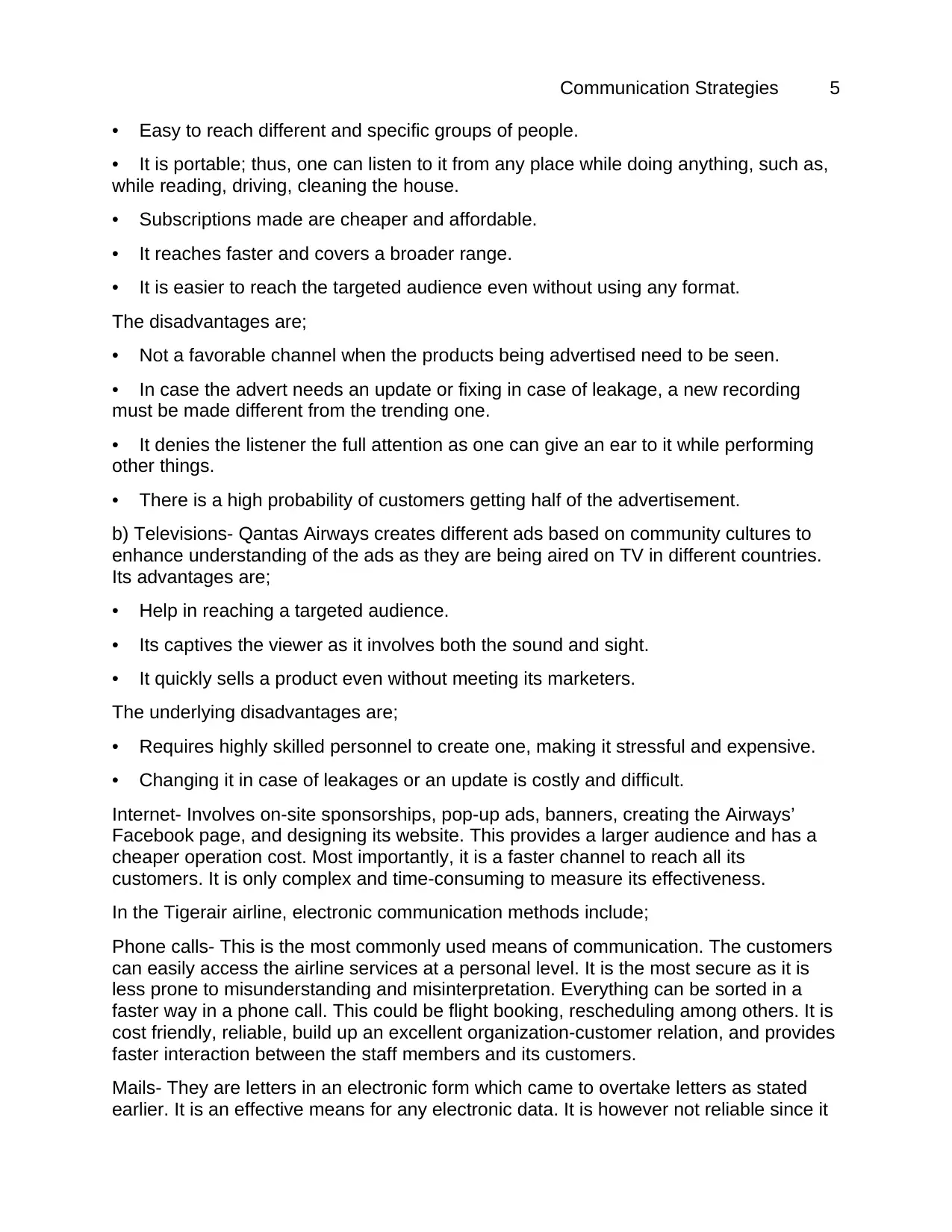
Communication Strategies 5
• Easy to reach different and specific groups of people.
• It is portable; thus, one can listen to it from any place while doing anything, such as,
while reading, driving, cleaning the house.
• Subscriptions made are cheaper and affordable.
• It reaches faster and covers a broader range.
• It is easier to reach the targeted audience even without using any format.
The disadvantages are;
• Not a favorable channel when the products being advertised need to be seen.
• In case the advert needs an update or fixing in case of leakage, a new recording
must be made different from the trending one.
• It denies the listener the full attention as one can give an ear to it while performing
other things.
• There is a high probability of customers getting half of the advertisement.
b) Televisions- Qantas Airways creates different ads based on community cultures to
enhance understanding of the ads as they are being aired on TV in different countries.
Its advantages are;
• Help in reaching a targeted audience.
• Its captives the viewer as it involves both the sound and sight.
• It quickly sells a product even without meeting its marketers.
The underlying disadvantages are;
• Requires highly skilled personnel to create one, making it stressful and expensive.
• Changing it in case of leakages or an update is costly and difficult.
Internet- Involves on-site sponsorships, pop-up ads, banners, creating the Airways’
Facebook page, and designing its website. This provides a larger audience and has a
cheaper operation cost. Most importantly, it is a faster channel to reach all its
customers. It is only complex and time-consuming to measure its effectiveness.
In the Tigerair airline, electronic communication methods include;
Phone calls- This is the most commonly used means of communication. The customers
can easily access the airline services at a personal level. It is the most secure as it is
less prone to misunderstanding and misinterpretation. Everything can be sorted in a
faster way in a phone call. This could be flight booking, rescheduling among others. It is
cost friendly, reliable, build up an excellent organization-customer relation, and provides
faster interaction between the staff members and its customers.
Mails- They are letters in an electronic form which came to overtake letters as stated
earlier. It is an effective means for any electronic data. It is however not reliable since it
• Easy to reach different and specific groups of people.
• It is portable; thus, one can listen to it from any place while doing anything, such as,
while reading, driving, cleaning the house.
• Subscriptions made are cheaper and affordable.
• It reaches faster and covers a broader range.
• It is easier to reach the targeted audience even without using any format.
The disadvantages are;
• Not a favorable channel when the products being advertised need to be seen.
• In case the advert needs an update or fixing in case of leakage, a new recording
must be made different from the trending one.
• It denies the listener the full attention as one can give an ear to it while performing
other things.
• There is a high probability of customers getting half of the advertisement.
b) Televisions- Qantas Airways creates different ads based on community cultures to
enhance understanding of the ads as they are being aired on TV in different countries.
Its advantages are;
• Help in reaching a targeted audience.
• Its captives the viewer as it involves both the sound and sight.
• It quickly sells a product even without meeting its marketers.
The underlying disadvantages are;
• Requires highly skilled personnel to create one, making it stressful and expensive.
• Changing it in case of leakages or an update is costly and difficult.
Internet- Involves on-site sponsorships, pop-up ads, banners, creating the Airways’
Facebook page, and designing its website. This provides a larger audience and has a
cheaper operation cost. Most importantly, it is a faster channel to reach all its
customers. It is only complex and time-consuming to measure its effectiveness.
In the Tigerair airline, electronic communication methods include;
Phone calls- This is the most commonly used means of communication. The customers
can easily access the airline services at a personal level. It is the most secure as it is
less prone to misunderstanding and misinterpretation. Everything can be sorted in a
faster way in a phone call. This could be flight booking, rescheduling among others. It is
cost friendly, reliable, build up an excellent organization-customer relation, and provides
faster interaction between the staff members and its customers.
Mails- They are letters in an electronic form which came to overtake letters as stated
earlier. It is an effective means for any electronic data. It is however not reliable since it
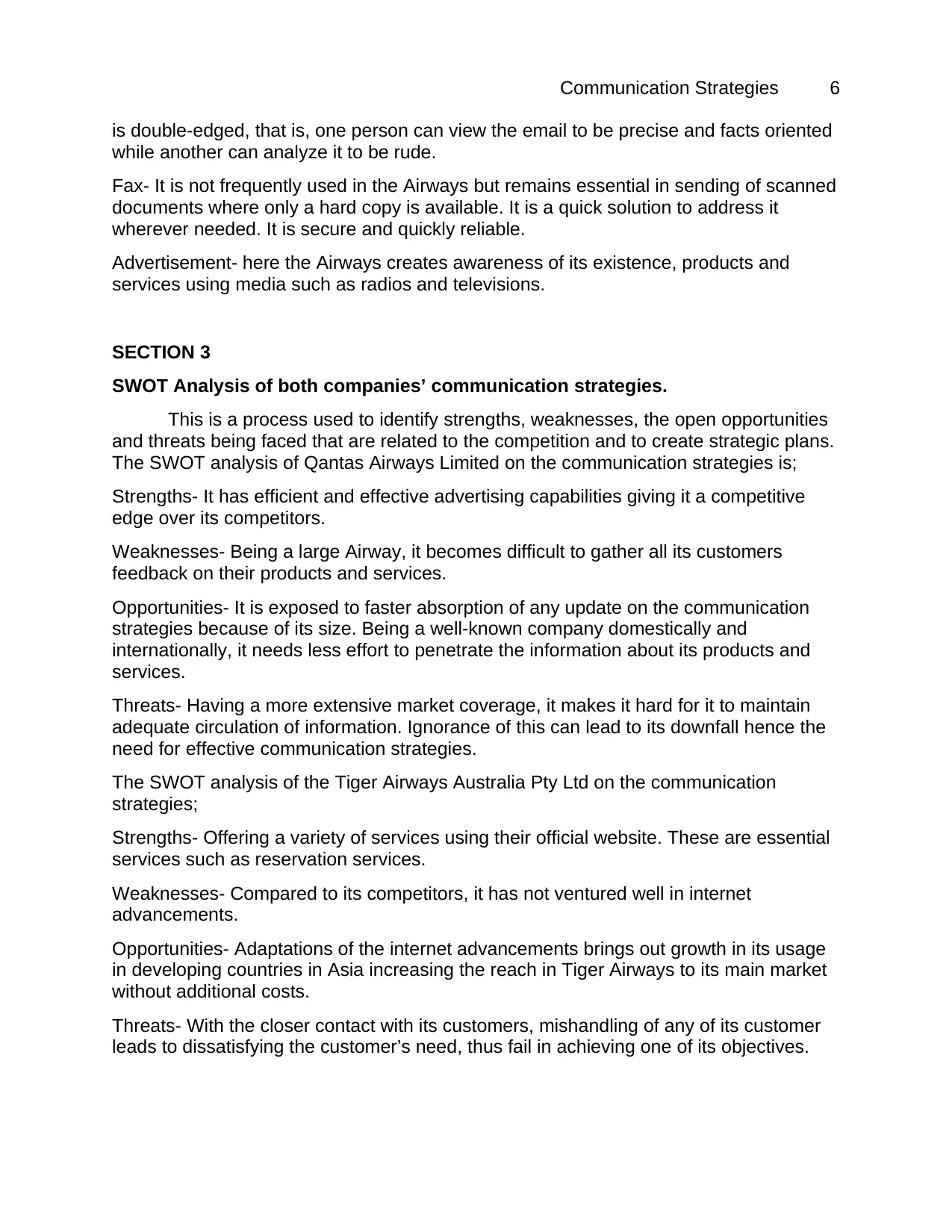
Communication Strategies 6
is double-edged, that is, one person can view the email to be precise and facts oriented
while another can analyze it to be rude.
Fax- It is not frequently used in the Airways but remains essential in sending of scanned
documents where only a hard copy is available. It is a quick solution to address it
wherever needed. It is secure and quickly reliable.
Advertisement- here the Airways creates awareness of its existence, products and
services using media such as radios and televisions.
SECTION 3
SWOT Analysis of both companies’ communication strategies.
This is a process used to identify strengths, weaknesses, the open opportunities
and threats being faced that are related to the competition and to create strategic plans.
The SWOT analysis of Qantas Airways Limited on the communication strategies is;
Strengths- It has efficient and effective advertising capabilities giving it a competitive
edge over its competitors.
Weaknesses- Being a large Airway, it becomes difficult to gather all its customers
feedback on their products and services.
Opportunities- It is exposed to faster absorption of any update on the communication
strategies because of its size. Being a well-known company domestically and
internationally, it needs less effort to penetrate the information about its products and
services.
Threats- Having a more extensive market coverage, it makes it hard for it to maintain
adequate circulation of information. Ignorance of this can lead to its downfall hence the
need for effective communication strategies.
The SWOT analysis of the Tiger Airways Australia Pty Ltd on the communication
strategies;
Strengths- Offering a variety of services using their official website. These are essential
services such as reservation services.
Weaknesses- Compared to its competitors, it has not ventured well in internet
advancements.
Opportunities- Adaptations of the internet advancements brings out growth in its usage
in developing countries in Asia increasing the reach in Tiger Airways to its main market
without additional costs.
Threats- With the closer contact with its customers, mishandling of any of its customer
leads to dissatisfying the customer’s need, thus fail in achieving one of its objectives.
is double-edged, that is, one person can view the email to be precise and facts oriented
while another can analyze it to be rude.
Fax- It is not frequently used in the Airways but remains essential in sending of scanned
documents where only a hard copy is available. It is a quick solution to address it
wherever needed. It is secure and quickly reliable.
Advertisement- here the Airways creates awareness of its existence, products and
services using media such as radios and televisions.
SECTION 3
SWOT Analysis of both companies’ communication strategies.
This is a process used to identify strengths, weaknesses, the open opportunities
and threats being faced that are related to the competition and to create strategic plans.
The SWOT analysis of Qantas Airways Limited on the communication strategies is;
Strengths- It has efficient and effective advertising capabilities giving it a competitive
edge over its competitors.
Weaknesses- Being a large Airway, it becomes difficult to gather all its customers
feedback on their products and services.
Opportunities- It is exposed to faster absorption of any update on the communication
strategies because of its size. Being a well-known company domestically and
internationally, it needs less effort to penetrate the information about its products and
services.
Threats- Having a more extensive market coverage, it makes it hard for it to maintain
adequate circulation of information. Ignorance of this can lead to its downfall hence the
need for effective communication strategies.
The SWOT analysis of the Tiger Airways Australia Pty Ltd on the communication
strategies;
Strengths- Offering a variety of services using their official website. These are essential
services such as reservation services.
Weaknesses- Compared to its competitors, it has not ventured well in internet
advancements.
Opportunities- Adaptations of the internet advancements brings out growth in its usage
in developing countries in Asia increasing the reach in Tiger Airways to its main market
without additional costs.
Threats- With the closer contact with its customers, mishandling of any of its customer
leads to dissatisfying the customer’s need, thus fail in achieving one of its objectives.
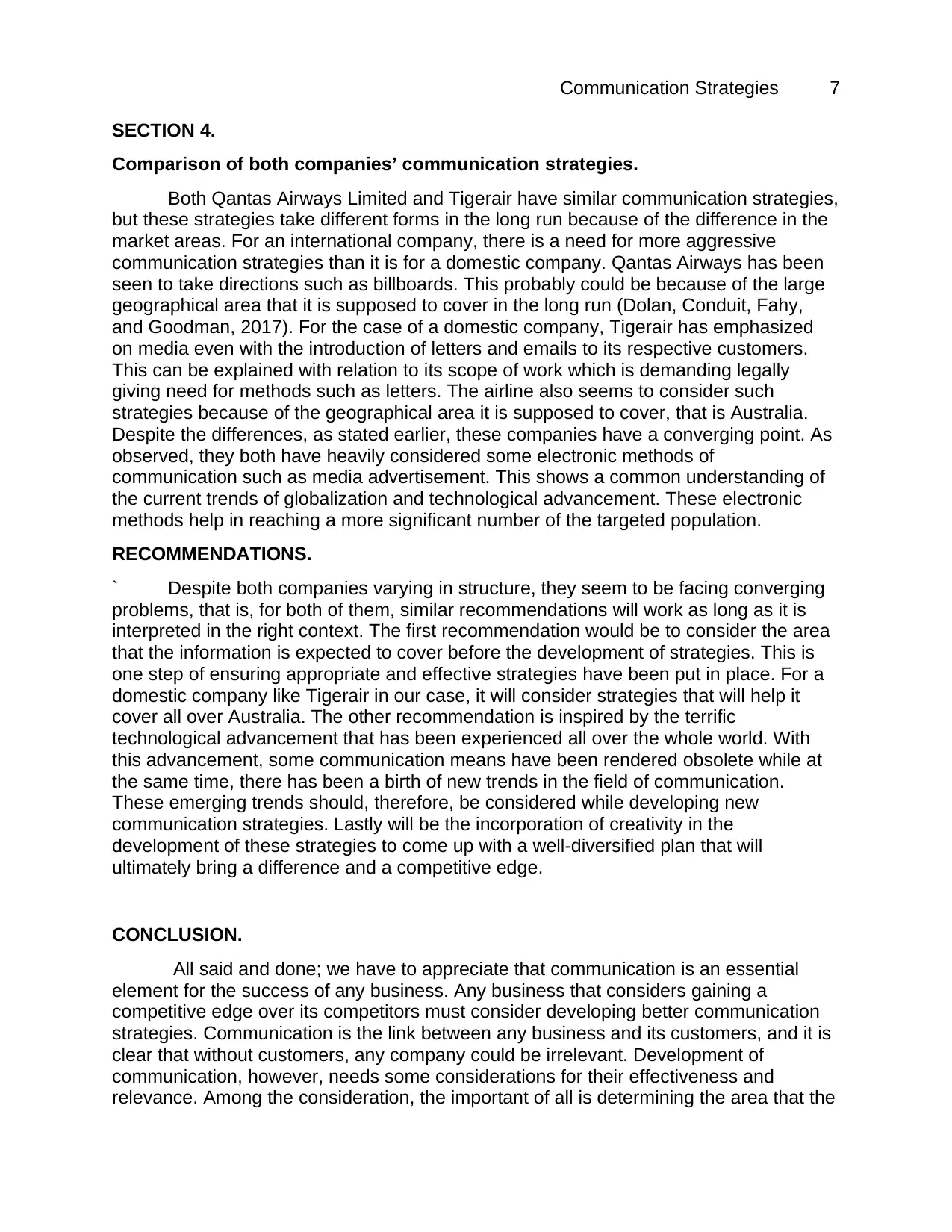
Communication Strategies 7
SECTION 4.
Comparison of both companies’ communication strategies.
Both Qantas Airways Limited and Tigerair have similar communication strategies,
but these strategies take different forms in the long run because of the difference in the
market areas. For an international company, there is a need for more aggressive
communication strategies than it is for a domestic company. Qantas Airways has been
seen to take directions such as billboards. This probably could be because of the large
geographical area that it is supposed to cover in the long run (Dolan, Conduit, Fahy,
and Goodman, 2017). For the case of a domestic company, Tigerair has emphasized
on media even with the introduction of letters and emails to its respective customers.
This can be explained with relation to its scope of work which is demanding legally
giving need for methods such as letters. The airline also seems to consider such
strategies because of the geographical area it is supposed to cover, that is Australia.
Despite the differences, as stated earlier, these companies have a converging point. As
observed, they both have heavily considered some electronic methods of
communication such as media advertisement. This shows a common understanding of
the current trends of globalization and technological advancement. These electronic
methods help in reaching a more significant number of the targeted population.
RECOMMENDATIONS.
` Despite both companies varying in structure, they seem to be facing converging
problems, that is, for both of them, similar recommendations will work as long as it is
interpreted in the right context. The first recommendation would be to consider the area
that the information is expected to cover before the development of strategies. This is
one step of ensuring appropriate and effective strategies have been put in place. For a
domestic company like Tigerair in our case, it will consider strategies that will help it
cover all over Australia. The other recommendation is inspired by the terrific
technological advancement that has been experienced all over the whole world. With
this advancement, some communication means have been rendered obsolete while at
the same time, there has been a birth of new trends in the field of communication.
These emerging trends should, therefore, be considered while developing new
communication strategies. Lastly will be the incorporation of creativity in the
development of these strategies to come up with a well-diversified plan that will
ultimately bring a difference and a competitive edge.
CONCLUSION.
All said and done; we have to appreciate that communication is an essential
element for the success of any business. Any business that considers gaining a
competitive edge over its competitors must consider developing better communication
strategies. Communication is the link between any business and its customers, and it is
clear that without customers, any company could be irrelevant. Development of
communication, however, needs some considerations for their effectiveness and
relevance. Among the consideration, the important of all is determining the area that the
SECTION 4.
Comparison of both companies’ communication strategies.
Both Qantas Airways Limited and Tigerair have similar communication strategies,
but these strategies take different forms in the long run because of the difference in the
market areas. For an international company, there is a need for more aggressive
communication strategies than it is for a domestic company. Qantas Airways has been
seen to take directions such as billboards. This probably could be because of the large
geographical area that it is supposed to cover in the long run (Dolan, Conduit, Fahy,
and Goodman, 2017). For the case of a domestic company, Tigerair has emphasized
on media even with the introduction of letters and emails to its respective customers.
This can be explained with relation to its scope of work which is demanding legally
giving need for methods such as letters. The airline also seems to consider such
strategies because of the geographical area it is supposed to cover, that is Australia.
Despite the differences, as stated earlier, these companies have a converging point. As
observed, they both have heavily considered some electronic methods of
communication such as media advertisement. This shows a common understanding of
the current trends of globalization and technological advancement. These electronic
methods help in reaching a more significant number of the targeted population.
RECOMMENDATIONS.
` Despite both companies varying in structure, they seem to be facing converging
problems, that is, for both of them, similar recommendations will work as long as it is
interpreted in the right context. The first recommendation would be to consider the area
that the information is expected to cover before the development of strategies. This is
one step of ensuring appropriate and effective strategies have been put in place. For a
domestic company like Tigerair in our case, it will consider strategies that will help it
cover all over Australia. The other recommendation is inspired by the terrific
technological advancement that has been experienced all over the whole world. With
this advancement, some communication means have been rendered obsolete while at
the same time, there has been a birth of new trends in the field of communication.
These emerging trends should, therefore, be considered while developing new
communication strategies. Lastly will be the incorporation of creativity in the
development of these strategies to come up with a well-diversified plan that will
ultimately bring a difference and a competitive edge.
CONCLUSION.
All said and done; we have to appreciate that communication is an essential
element for the success of any business. Any business that considers gaining a
competitive edge over its competitors must consider developing better communication
strategies. Communication is the link between any business and its customers, and it is
clear that without customers, any company could be irrelevant. Development of
communication, however, needs some considerations for their effectiveness and
relevance. Among the consideration, the important of all is determining the area that the
Paraphrase This Document
Need a fresh take? Get an instant paraphrase of this document with our AI Paraphraser

Communication Strategies 8
information is expected to cover and the people therein. This helps in packaging
information in a manner that the targeted audience will consider and receive. It is also
clear of the rising popularity of the electronic methods of communication which have
been brought by more people embracing technology. This even an eye-opener to any
business that has been left behind to consider venturing to this new direction. It also
implies that there is a need for the company not to be rigid as far as their
communication is concerned since this is a very dynamic area. Magazines might have
been prominent some years back, but the case is different today, the internet is the new
king in the market place today.
information is expected to cover and the people therein. This helps in packaging
information in a manner that the targeted audience will consider and receive. It is also
clear of the rising popularity of the electronic methods of communication which have
been brought by more people embracing technology. This even an eye-opener to any
business that has been left behind to consider venturing to this new direction. It also
implies that there is a need for the company not to be rigid as far as their
communication is concerned since this is a very dynamic area. Magazines might have
been prominent some years back, but the case is different today, the internet is the new
king in the market place today.

Communication Strategies 9
REFERENCES.
Caputo, F. and Evangelista, F., 2018. The role of Information sharing and
communication strategies for improving stakeholder engagement. In Business Models
for Strategic Innovation (pp. 51-69). Routledge.
Crotty, D., 2018. Travelling in style: Qantas in the deco era. Spirit of Progress, 19(1),
p.17.
Dolan, R., Conduit, J., Fahy, J. and Goodman, S., 2017. Social media: communication
strategies, engagement and future research directions. International Journal of Wine
Business Research, 29(1), pp.2-19.
Hussain, S., Ryan, M., Cripps, H. and Lambert, C., 2017. Role of social media in
handling a crisis situation: A case study of Commonwealth Bank of Australia (CBA).
In The proceedings of 2nd Business Doctoral and Emerging Scholars Conference(p.
98).
Quirke, B., 2017. Making the connections: using internal communication to turn strategy
into action. Routledge.
Rasche, A., Morsing, M. and Moon, J. eds., 2017. Corporate social responsibility:
strategy, communication, governance. Cambridge University Press.
Raynes, C. and Tsui, K.W.H., 2019. Review of Airline-within-Airline strategy: Case
studies of the Singapore Airlines Group and Qantas Group. Case Studies on Transport
Policy, 7(1), pp.150-165.
Wang, K., Tsui, K.W.H., Liang, L. and Fu, X., 2017. Entry patterns of low-cost carriers in
Hong Kong and implications to the regional market. Journal of Air Transport
Management, 64, pp.101-112.
Whyte, R. and Lohmann, G., 2015. The carrier-within-a-carrier strategy: An analysis of
Jetstar. Journal of Air Transport Management, 42, pp.141-148.
REFERENCES.
Caputo, F. and Evangelista, F., 2018. The role of Information sharing and
communication strategies for improving stakeholder engagement. In Business Models
for Strategic Innovation (pp. 51-69). Routledge.
Crotty, D., 2018. Travelling in style: Qantas in the deco era. Spirit of Progress, 19(1),
p.17.
Dolan, R., Conduit, J., Fahy, J. and Goodman, S., 2017. Social media: communication
strategies, engagement and future research directions. International Journal of Wine
Business Research, 29(1), pp.2-19.
Hussain, S., Ryan, M., Cripps, H. and Lambert, C., 2017. Role of social media in
handling a crisis situation: A case study of Commonwealth Bank of Australia (CBA).
In The proceedings of 2nd Business Doctoral and Emerging Scholars Conference(p.
98).
Quirke, B., 2017. Making the connections: using internal communication to turn strategy
into action. Routledge.
Rasche, A., Morsing, M. and Moon, J. eds., 2017. Corporate social responsibility:
strategy, communication, governance. Cambridge University Press.
Raynes, C. and Tsui, K.W.H., 2019. Review of Airline-within-Airline strategy: Case
studies of the Singapore Airlines Group and Qantas Group. Case Studies on Transport
Policy, 7(1), pp.150-165.
Wang, K., Tsui, K.W.H., Liang, L. and Fu, X., 2017. Entry patterns of low-cost carriers in
Hong Kong and implications to the regional market. Journal of Air Transport
Management, 64, pp.101-112.
Whyte, R. and Lohmann, G., 2015. The carrier-within-a-carrier strategy: An analysis of
Jetstar. Journal of Air Transport Management, 42, pp.141-148.
1 out of 9
Related Documents
Your All-in-One AI-Powered Toolkit for Academic Success.
+13062052269
info@desklib.com
Available 24*7 on WhatsApp / Email
![[object Object]](/_next/static/media/star-bottom.7253800d.svg)
Unlock your academic potential
© 2024 | Zucol Services PVT LTD | All rights reserved.





